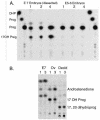Deletion of the mouse P450c17 gene causes early embryonic lethality
- PMID: 15169901
- PMCID: PMC419874
- DOI: 10.1128/MCB.24.12.5383-5390.2004
Deletion of the mouse P450c17 gene causes early embryonic lethality
Abstract
Dehydroepiandrosterone (DHEA), a 19-carbon precursor of sex steroids, is abundantly produced in the human but not the mouse adrenal. However, mice produce DHEA and DHEA-sulfate (DHEAS) in the fetal brain. DHEA stimulates axonal growth from specific populations of mouse neocortical neurons in vitro, while DHEAS stimulates dendritic growth from those cells. The synthesis of DHEA and sex steroids, but not mouse glucocorticoids and mineralocorticoids, requires P450c17, which catalyzes both 17 alpha-hydroxylase and 17,20-lyase activities. We hypothesized that P450c17-knockout mice would have disordered sex steroid synthesis and disordered brain DHEA production and thus provide phenotypic clues about the functions of DHEA in mouse brain development. We deleted the mouse P450c17 gene in 127/SvJ mice and obtained several lines of mice from two lines of targeted embryonic stem cells. Heterozygotes were phenotypically and reproductively normal, but in all mouse lines, P450c17(-/-) zygotes died by embryonic day 7, prior to gastrulation. The cause of this early lethality is unknown, as there is no known function of fetal steroids at embryonic day 7. Immunocytochemistry identified P450c17 in embryonic endoderm in E7 wild-type and heterozygous embryos, but its function in these cells is unknown. Enzyme assays of wild-type embryos showed a rapid rise in 17-hydroxylase activity between E6 and E7 and the presence of C(17,20)-lyase activity at E7. Treatment of pregnant females with subcutaneous pellets releasing DHEA or 17-OH pregnenolone at a constant rate failed to rescue P450c17(-/-) fetuses. Treatment of normal pregnant females with pellets releasing pregnenolone or progesterone did not cause fetal demise. These data suggest that steroid products of P450c17 have heretofore-unknown essential functions in early embryonic mouse development.
Figures




References
-
- Albrecht, E. D., and G. J. Pepe. 1990. Placental steroid hormone biosynthesis in primate pregnancy. Endocr. Rev. 11:124-150. - PubMed
-
- Arensburg, J., A. H. Payne, and J. Orly. 1999. Expression of steroidogenic genes in maternal and extraembryonic cells during early pregnancy in mice. Endocrinology 140:5220-5232. - PubMed
-
- Auchus, R. J., and M. K. Gupta. 2002. Towards a unifying mechanism for CYP17 mutations that cause isolated 17,20-lyase deficiency. Endocr. Res. 28:443-447. - PubMed
-
- Auchus, R. J., T. C. Lee, and W. L. Miller. 1998. Cytochrome b5 augments the 17,20-lyase activity of human P450c17 without direct electron transfer. J. Biol. Chem. 273:3158-3165. - PubMed
-
- Auchus, R. J., and W. L. Miller. 1999. Molecular modeling of human P450c17 (17α-hydroxylase/17,20-lyase): insights into reaction mechanisms and effects of mutations. Mol. Endocrinol. 13:1169-1182. - PubMed
Publication types
MeSH terms
Substances
Grants and funding
LinkOut - more resources
Full Text Sources
Molecular Biology Databases
